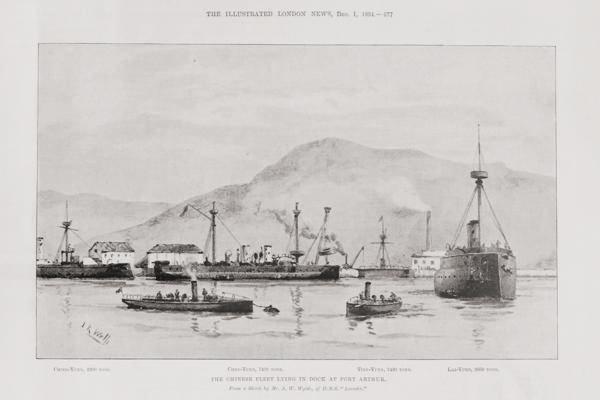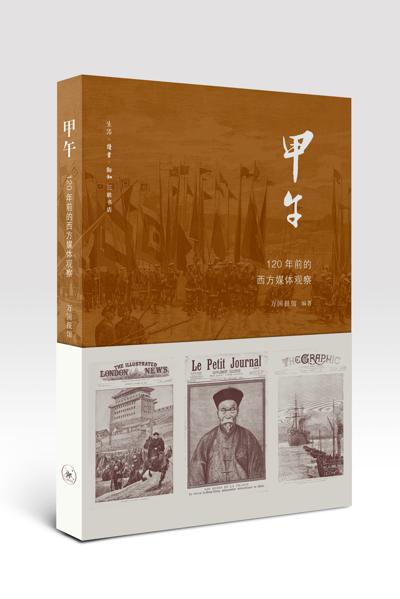
A Dec 1, 1894, issue of The Illustrated London News features a sketch of the Chinese fleet docked at Port Arthur (now known as Port Lushun).[Photo/China Daily]
As the Chinese traditionally record history in cycles of 60 years, 2014 is of significance because it marks the 120th anniversary of the First Sino-Japanese War, known as the Battle of Jiawu in China.
Dozens of books have been published on the subject.
Written by Chinese scholars, novelists and military officials, these books provide analyses of the defeat of the Qing Dynasty (1644-1911) from a Chinese perspective. But Jiawu-Observations of the Western Press 120 Years Ago, published by Sanlian Joint Publishing Bookstore, has chosen an unusual angle, presenting the war as reported by Western newspapers.
The book translated more than 300 war-related news items, most of which were printed in 1894-95, from publications such as the now defunct European newspapers The Illustrated London News and Le Petit Journal, and Harper’s Weekly of the United States.
Since most of the reports from which the book is drawn were either accompanied by pictures or were photo essays, the book gives readers a vivid picture of how the Western media presented the war to the world.
“We were surprised to discover the great interest in the West about the war, and how differently they saw it,” says Tian Tong, a Beijing-based journalist and one of the book’s main editors.
“In China, the Battle of Jiawu is considered an invasion. Yet little sympathy was found in those stories and pictures. Instead, China was portrayed as a closed state, with its people xenophobic and its officials overly bureaucratic. Japan was shown to be a more civilized country-strong in their military and caring of their soldiers.”
The war was fought at sea, and the newspapers had engaged in a public perception battle to present their own versions of it to Western readers.
Despite some restrictions, Japan allowed foreign journalists to be embedded in their troops. They hired a New York Tribune journalist, Edward House, to be their media adviser, and organized many publicity campaigns.
In contrast, the Qing officials not only underestimated the power of the media, but also attempted to block the news of their failures on the battlegrounds.
One of the rare newspaper pieces Tian collected is the front page of the erstwhile The New York World from its edition dated Dec 20, 1894, which published a damning report by American journalist James Creelman on the Port Arthur Massacre carried out by the Japanese.
Port Lushun, known as Port Arthur at the time, is on the coast of Liaoning province in northeastern China.
“The struggle for the emancipation of Corea (Korea) is suddenly turned into a headlong, savage war of conquest. It is no longer a conflict between civilization and barbarism. Japan has dropped her mask and for the last four days she has trampled civilization under the feet of her conquering army,” Creelman wrote in his lead story.
But the silence on the part of the Qing rulers on the massacre and Japanese efforts to bury the truth raised doubts about the credibility of the report and allowed Japan to be free from blame for at least some time.
Tian says: “These newspapers influenced Western society’s opinion of Asia, and to some extent, Western decision-makers. That’s one of the main reasons why we started this study.”
The idea of compiling the news reports into a book first came to Tian when he was covering the 2012 London Olympics for a Chinese TV channel. As a collector of old newspapers, he found a bundle of The Illustrated London News that carried reports about China from the Qing Dynasty era when he was strolling down Portobello Road to take a look at London’s famous antique market.
He brought back to China about 100 old British newspapers, and quickly found a group of friends who shared the same passion in unearthing reports of the war from such papers.
For the past two years, Tian and his friends rummaged through war-related news material from book dealers and universities. Besides English newspapers, they also bought French, Russian and Japanese ones from sellers of old publications.
“Studying the newspapers was like going back through a time tunnel,” says Tian. “We are not historians, so we didn’t provide any commentary in our book. We want readers to make their own conclusions.”
THE WAR IN EYES OF THE WESTERN PRESS

Jiawu-Observations of the Western Press 120 Years Ago[Photo/China Daily]
Harper’s Weekly, Aug 25, 1894:
China’s military preparations in the second half of this century are almost wholly in the line of defense. It may be safely said that, except in the border state, she has no ability to carry on a foreign war.
The Illustrated London News, Sept 29, 1894:
The destruction of ships, in proportion to the number engaged in conflicts, was unusually great, and so was the loss of life. Three of the strongest Chinese warships were sunk, while another was burnt or blown up. The Chinese succeeded, having begun work at an earlier hour, in landing troops from the transports which they convoyed. But they cannot be deemed to have escaped a naval defeat, and their forces at sea are much weakened, probably beyond repair.
The Illustrated London News, Nov 24, 1894:
Some of these raw levies have, in their march toward the seat of war, perpetrated robberies and murders and other outrages. They are more to be dreaded than the Japanese soldiers.
The Graphic, Dec 1, 1894:
The Chinese cruiser Chih Yuen, commanded by Captain Tang, early in the fight closed with one of the enemy’s ships with the intention of ramming, but was herself then attacked by four Japanese ships which closed around her. The Chih Yuen under this combined attack was ripped up by shots under the water and went down with all on board.
The New York World, Dec 20, 1894:
At least two thousand helpless people butchered by Japanese soldiers. Three days of slaughter. Gen Oyama and his officers made no attempt to stop the atrocities. The town sacked from end to end. Streets choked with mutilated bodies of men, women and children while the soldiers laughed.
(EXCERPTS FROM JIAWU-OBSERVATIONS OF THE WESTERN PRESS 120 YEARS AGO)
